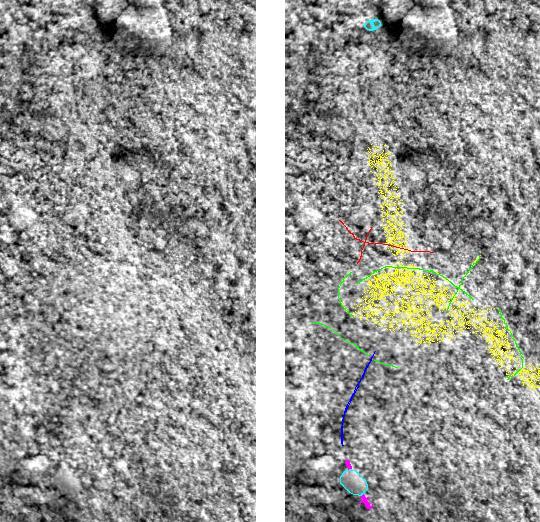|
|
June 10, 2004 -- Studies from Opp sol 125 from outside the Endurance crater:
The following material was derived from the Opp sol 125 microphotographs.
The cloaked spherule shown across was added to the bottom of the spherules page.
A
second interesting image elaborating on the cloaked one,
showing, at a minimum a hard structure comparable
to the "golf-tee" leading to the spherule,
but, wildly speculating, suggesting a soft tissue body around the spherule.
From
/1/m/125/1M139280589EFF2829P2976M2M1
|
|
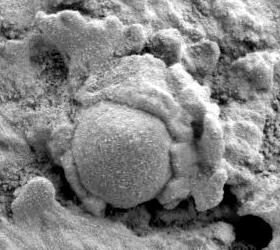
|
A new spherule inner core image:
The outer spherule has eroded away leaving the cylindrical inner core
complete with the inner-most tube.
/1/m/106/1M137593512EFF2208P2956M2M1
|
|
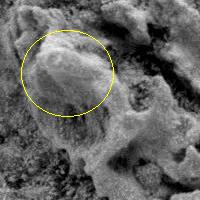
|
Not exactly hallucinogenia, but concentric circular arcs from Opp sol 125 outside of Endurance Crater.
About 2 mm in diameter. New in Soil Studies.
/1/m/125/1M139283564EFF2829P2976M2M1
|
|
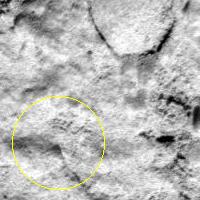
|
|
Algae Studies from Sol 125:
Were the evaporitic sediments from outside the Endurance crater microbially influenced?
A few Opportunity sol 125 microscopic images from outside the crater
were added to the bottom of the Algae page exploring this idea.
In general the sol 125 microscopic images were a great disappointment to Mars observers
seeking macro-fossils at Meridiani. The Opportunity rover sent back many beautifully focused
and well-lit images of a clean exposed rock surface with many fine sub-millimeter details
exposed from eons of weathering. However, the rocks seemed completely sterile. Where the
observer was hoping for more rotinis, hallucinogenia, spherule stems, sea weed, or other
fossil traces of algae growth, nothing was forth-coming.
|
|
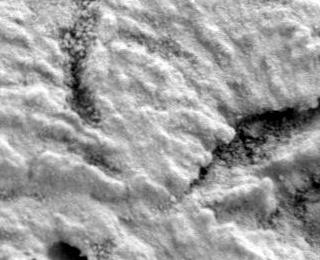
|
|
|
May 29, 2004 -- Did the Spherules Grow Originally in Lines?
I clairified my thought and added material in the
"Did the Spherules Grow Originally in Lines?" and
"Images of the Spherules in Situ" on the Spherules page.
I also added this picture from
/1/p/118/1P138654324EFF2809P2298L2M1
"In this image our spherules are presented nicely growing in lines
on a single strata layer,
each spherule separated by half an inch or so of free space just like with the Horodyskia.
On the larger NASA image, is that an ancient rain water wash channel between the rocks? Could the wind do that over time? Opp sol 118 Pancam."
I also added the
Mysterious Basalt Rock with Square Hole
from Spirit sol 014 about half the way down the Tourism page.
|
|
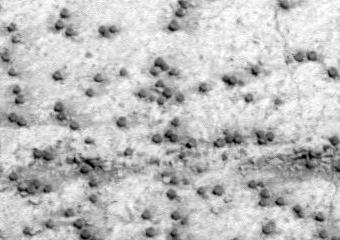
|
|
|
May 28, 2004 -- Improvements to "Soil Studies"
I re-worked the second half of the "Soil Studies" page, adding a lot of
interesting material about filaments and threads found in the soil.
This includes this stunning find by Hamdi Ucar of Turkey
of a spirally wrapped thread.
Probally not a fossil, but stunning nonetheless.
Also an Opp sol 25 contribution from Marvi and there is something new from Spirit sol 105.
So, check out the Soils Studies Page.
I also added a picture of the Opportunity Aeroshell from the Endurance crater in
the Mars Tourism page.
|
|
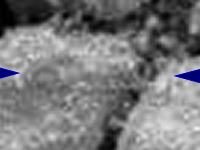

|
|
|
|
May 17, 2004 -- Dimple explanation #1 - non-biological:
Three non-biological explanations for the spherule dimples are proposed.
Explanation #1 is the best and the other two are less satisfactory.
Dimple explanation #1 - non-biological:
A feeder canal of mineralized fluid leads to each concretion.
The concretion grows in diameter and envelopes the feeder canal.
The spherule breaks away from the feeder canal and the dimple is
the root of feeder canal leading into the spherule.
The observations that support this theory and which the theory seeks to explain are
the plumbing holes in the mother rock around the spherule and vugs,
the dimples and the holes in the spherules,
the "golf tee" and other fossilized stalks,
the central cylindrical core found in some spherules, and
the roots and stalks and "golf tee" stalks, being in fact the mineralized canals,
leading to some in situ spherules.
Important point -- as shown later on in this article, spherules have an
hard outer crust. The interaction between the outer crust and the
mineralized canal may contribute to the dimple.
|
|
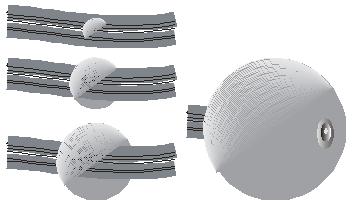
|
|
|
May 15, 2004 -- Not a Trilobite:
I got a few emails about this feature asking if it was a new type of fossil.
It is more likely the base of a spherule still cemented into the rock.
The top of the spherule has eroded away.
The scalloped edges are something new.
Opportunity sol 105.
/1/m/105/1M137504929EFF2208P2936M2M1. |
|
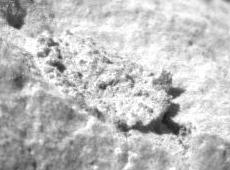 |
|
|
May 15, 2004 -- Rotinis as abrasion artifacts: Here is a
similar-looking rotini-thingy created from the dust of grinding.
The original rotini looks much more solid and robust than the second rotini-thingy does.
It would be a stretch to compare them and say the original rotini was an abrasion artifact.
Even with harder rock and a deeper crack to fall in. Opportunity sol 108.
/1/m/108/1M137782381EFF2222P2956M2M1.
The abrasion dust rotini-thingy is about 2 inches over and 2 inches down from the top left corner
of this image.
| |

|
|
May 12, 2004 -- Back room: Four objects from Opportunity Sol 106:
From top left clockwise.
A weird something hiding in the shadows.
A bit of disintegrating sediment.
A piece of sediment that at one time held two spherules close enough together to kiss.
A dimpled spherule with lines radiating from the dimple.
/1/m/106/1M137593860EFF2208P2956M2M1. |
|
 |
Spherules May 13, 2004 -- 7.B/ Opportunity Sol 106. An amazing shot of the spherule eroding away from a cylindrical inner core.
This cylindrical inner core is an extension from my hypothesized root and dimple.
This is a bit bizarre.
Sometimes you see the root dimples as craters because the root is softer and it erodes out.
Now the root core is harder than the spherule and the outer spherule erodes off first.
From Hamdi Ucar of Turkey.
Enlarged double size.
The stone it is in is 2.5 mm in diameter. The cylindrical core is about .7 mm diameter.
Beside it is a detail of two oddly eroded rocks from the same picture.
/1/m/106/1M137593512EFF2208P2956M2M1

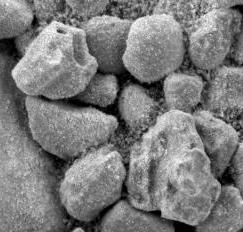
May 12, 2004. Mars Fossils - version 2.0 is first deployed.
The definitive statement from the guys over at the Space.com bulletin board
about my Mars Fossils web page.







